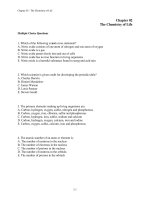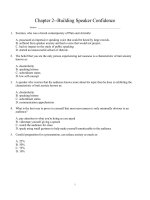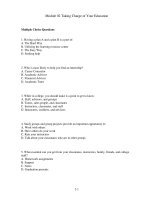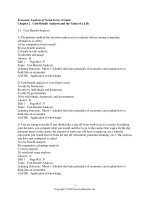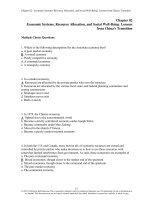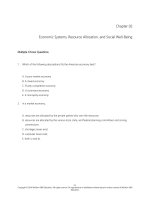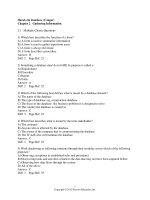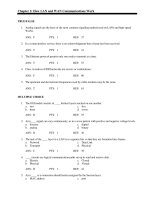Economic analysis of social issues 1st edition alan grant test bank
Bạn đang xem bản rút gọn của tài liệu. Xem và tải ngay bản đầy đủ của tài liệu tại đây (225.67 KB, 26 trang )
Economic Analysis of Social Issues (Grant)
Chapter 2 Cost-Benefit Analysis and the Value of a Life
2.1 Cost-Benefit Analysis
1) The primary method that decision makers use to evaluate choices among competing
alternatives is called
A) the competitive forces model.
B) cost-benefit analysis.
C) heads-or-tails analysis.
D) absolute advantage.
Answer: B
Diff: 1
Page Ref: 37
Topic: Cost-Benefit Analysis
Learning Outcome: Micro-1: Identify the basic principles of economics and explain how to
think like an economist.
AACSB : Application of knowledge
2) Cost-benefit analysis is a tool that is used
A) only by businesses.
B) only by individuals and businesses.
C) only by governments.
D) by individuals, businesses, and governments.
Answer: D
Diff: 1
Page Ref: 37
Topic: Cost-Benefit Analysis
Learning Outcome: Micro-1: Identify the basic principles of economics and explain how to
think like an economist.
AACSB : Application of knowledge
3) You are trying to decide if you should take a day off from work to go to a casino. In making
your decision, you compare what you would sacrifice to go to the casino (lost wages for the day,
potential losses at the casino, the amount of work you will have to make up, etc.) with the
enjoyment you would receive from the day off (relaxation, potential winnings, etc.). The analysis
you have just conducted is called
A) cost-benefit analysis.
B) comparative advantage analysis.
C) stress analysis.
D) sacrificial-wage analysis.
Answer: A
Diff: 1
Page Ref: 37
Topic: Cost-Benefit Analysis
Learning Outcome: Micro-1: Identify the basic principles of economics and explain how to
think like an economist.
AACSB : Application of knowledge
1
Copyright © 2016 Pearson Education, Inc.
4) You are trying to decide if you should take a vacation. Your cost-benefit analysis indicates
that the benefits outweigh the costs. You should
A) take a vacation.
B) not take a vacation.
C) take a vacation only if you have enough cash saved up to pay for it up front.
D) More information is needed to make this decision.
Answer: A
Diff: 1 Page Ref: 37
Topic: Cost-Benefit Analysis
Learning Outcome: Micro-1: Identify the basic principles of economics and explain how to
think like an economist.
AACSB : Application of knowledge
5) Claudia's Copy Shop is deciding which 3-D printer to purchase, and it only has room for one
printer. It can purchase the "Mini-Me" small-object printer, which would generate benefits of
$50,000 at a cost of $5,000, or it can purchase the "Gargantuan" large-object printer which
would generate benefits of $250,000 at a cost of $25,000. Based on these numbers, Claudia's
Copy Shop should purchase
A) the "Mini-Me" printer.
B) the "Gargantuan" printer.
C) either printer, since the cost of each is exactly 10 percent of the benefit from each.
D) neither printer, since the cost of each is too high for a 3-D printer.
Answer: B
Diff: 2
Page Ref: 38
Topic: Using Cost-Benefit Analysis to Select Among Competing Alternatives
Learning Outcome: Micro-1: Identify the basic principles of economics and explain how to
think like an economist.
AACSB : Analytic thinking
6) Gerald is deciding what kind of light bulbs to install in the light fixtures in his new home. He
has it narrowed down to compact fluorescent bulbs (CFLs) or LED bulbs. The CFLs will cost
$350 and the LEDs will cost $900. Gerald estimates that the energy-saving benefits from the
CFLs will be $750 and the energy-saving benefits from the LEDs will be $1,250. Based on these
numbers, Gerald should purchase the
A) CFLs because the cost is cheaper.
B) CFLs because the the net benefit is greater.
C) LEDs because the benefit is greater.
D) LEDs because the net benefit is greater.
Answer: B
Diff: 2
Page Ref: 38
Topic: Using Cost-Benefit Analysis to Select Among Competing Alternatives
Learning Outcome: Micro-1: Identify the basic principles of economics and explain how to
think like an economist.
AACSB : Analytic thinking
2
Copyright © 2016 Pearson Education, Inc.
7) Marginal cost refers to the ________ cost incurred when choosing a particular action.
A) total
B) net
C) implicit
D) additional
Answer: D
Diff: 1
Page Ref: 38
Topic: Evaluating Alternatives at the Margin
Learning Outcome: Micro-1: Identify the basic principles of economics and explain how to
think like an economist.
AACSB : Application of knowledge
8) The additional benefit incurred when undertaking an activity is the ________ benefit.
A) total
B) gross
C) marginal
D) explicit
Answer: C
Diff: 1
Page Ref: 38
Topic: Evaluating Alternatives at the Margin
Learning Outcome: Micro-1: Identify the basic principles of economics and explain how to
think like an economist.
AACSB : Application of knowledge
9) Bruno makes tamales to sell at the local farmer's market, and each month he sells all he
makes. Each month, tamales had been selling for $10 per dozen and Bruno made 80 dozen
tamales at a total cost of $500. It costs Bruno $100 to rent a booth at the farmer's market. This
month, as Bruno is getting ready to pay management the $100 booth rental fee and display his
tamales, he discovers that he will need to cut his price to $5 per dozen to compete with other
tamale sellers. Bruno should
A) not pay the booth rental fee and not set up his booth because he has already spent $500 to
make his tamales and will only receive $400 by selling them.
B) only set up his booth if he does not have to pay the booth rental fee because then he will at
least break even.
C) go ahead and pay the fee and set up his booth because the marginal benefit of selling his
tamales is $400 and the marginal cost is $100.
D) not set up his booth this month because the marginal benefit of selling his tamales is $400 and
the marginal cost is $600.
Answer: C
Diff: 3
Page Ref: 38-39
Topic: Evaluating Alternatives at the Margin
Learning Outcome: Micro-20: Apply the concepts of opportunity cost, marginal analysis, and
present value to make decisions.
AACSB : Analytic thinking
3
Copyright © 2016 Pearson Education, Inc.
10) The cost-benefit analysis on the financial impact smokers have on society conducted by
Vanderbilt professor Kip Viscusi concludes that
A) smokers provide a net public service to society.
B) smokers are a financial drain on society.
C) smokers contribute less to retirement and pension programs than they receive from those
programs.
D) smokers account for about 32 cents of net cost to everyone else in society for every pack of
cigarettes smoked.
Answer: A
Diff: 1
Page Ref: 39
Topic: Evaluating Alternatives at the Margin
Learning Outcome: Micro-20: Apply the concepts of opportunity cost, marginal analysis, and
present value to make decisions.
AACSB : Application of knowledge
Special Feature: Application 2.1: Cost-Benefit Analysis and the Tobacco Settlement
11) ________ should be considered when conducting a cost-benefit analysis.
A) Total costs and total benefits
B) Only marginal costs and marginal benefits
C) Only implicit costs and implicit benefits
D) All costs and all benefits
Answer: B
Diff: 1
Page Ref: 40
Topic: Evaluating Alternatives at the Margin
Learning Outcome: Micro-20: Apply the concepts of opportunity cost, marginal analysis, and
present value to make decisions.
AACSB : Application of knowledge
12) When conducting cost-benefit analysis, it is important to ignore previously incurred costs
and previously received benefits.
Answer: TRUE
Diff: 2
Page Ref: 38
Topic: Evaluating Alternatives at the Margin
Learning Outcome: Micro-1: Identify the basic principles of economics and explain how to
think like an economist.
AACSB : Application of knowledge
13) Arriving at a decision by comparing total costs and total benefits is called marginal analysis.
Answer: FALSE
Diff: 1
Page Ref: 38
Topic: Evaluating Alternatives at the Margin
Learning Outcome: Micro-20: Apply the concepts of opportunity cost, marginal analysis, and
present value to make decisions.
AACSB : Application of knowledge
4
Copyright © 2016 Pearson Education, Inc.
14) An activity should be undertaken if the marginal benefit of the activity is greater than the
marginal cost of the activity.
Answer: TRUE
Diff: 1
Page Ref: 38
Topic: Evaluating Alternatives at the Margin
Learning Outcome: Micro-20: Apply the concepts of opportunity cost, marginal analysis, and
present value to make decisions.
AACSB : Application of knowledge
15) The additional costs you expect to incur if you undertake an activity and the additional
benefits you expect to receive if you undertake an activity are called ________ costs and benefits
Answer: marginal
Diff: 1
Page Ref: 38
Topic: Evaluating Alternatives at the Margin
Learning Outcome: Micro-1: Identify the basic principles of economics and explain how to
think like an economist.
AACSB : Application of knowledge
16) Lucinda is deciding whether to enroll in an art school or a culinary school. The art school
will cost $38,000 and the culinary school will cost $52,000. Lucinda estimates that the benefits
from attending the art school will be $75,000 and the benefits from attending the culinary school
will be $88,000. Based on these numbers, in which school should Lucinda enroll?
Answer: The net benefit from attending the art school is $75,000 - $38,000 = $37,000. The net
benefit from attending the culinary school is $88,000 - $52,000 = $36,000. So, even though the
total benefit is greater from attending the culinary school, the net benefit is greater from
attending the art school, so she should attend the art school.
Diff: 3
Page Ref: 38
Topic: Using Cost-Benefit Analysis to Select Among Competing Alternatives
Learning Outcome: Micro-1: Identify the basic principles of economics and explain how to
think like an economist.
AACSB : Analytic thinking
5
Copyright © 2016 Pearson Education, Inc.
17) Salvador grows orchids to sell to local florists. When Salvador began raising his current crop
of 1,000 orchids, he could sell them for $20 per plant, and he incurred shipping costs of $3 per
plant. His cost of raising orchids is $8 per plant. When his crop was ready to ship, florists were
only paying $9 per plant. Use marginal analysis to determine Salvador's best course of action
given the drop in the price of orchids.
Answer: When Salvador began raising his current crop of orchids, he expected to earn revenue
of $20,000 and incur costs of $8,000 for raising the plants and an additional $3,000 for shipping,
leaving him with a net (marginal) benefit of $9,000. With the drop in price, his revenue will be
$9,000 and his costs will be $11,000, leaving him with a loss of $2,000. Although it may seem as
though the best option for Salvador is to not sell his orchids at this lower price, the $8,000 cost of
raising the orchids has already been incurred, so if he chooses to not sell the orchids, he will lose
$8,000. If he chooses to sell his orchids, his net loss will only be $2,000. So by selling the
orchids, Salvador's marginal benefit is $9,000 and his marginal cost is the $3,000 shipping
expense. His best course of action is to sell the orchids, even at the lower price.
Diff: 3
Page Ref: 38-39
Topic: Evaluating Alternatives at the Margin
Learning Outcome: Micro-20: Apply the concepts of opportunity cost, marginal analysis, and
present value to make decisions.
AACSB : Analytic thinking
6
Copyright © 2016 Pearson Education, Inc.
2.2 Applying Cost-Benefit Analysis to Life
1) In the case of the Ford Pinto, Ford decided that
A) it would be cheaper to pay damages to families involved in crashes than to fix the problems
with the Pinto.
B) it would be more expensive to pay damages to families involved in crashes than to fix the
problems with the Pinto.
C) the problems with the Pinto could not be easily or cheaply fixed.
D) it would not be held liable for damages caused by the Pinto and therefore had no reason to fix
them.
Answer: A
Diff: 1
Page Ref: 40
Topic: Corporations Do It: The Ford Pinto
Learning Outcome: Micro-20: Apply the concepts of opportunity cost, marginal analysis, and
present value to make decisions.
AACSB : Application of knowledge
2) ________ regularly trade their own gain against others' lives.
A) Corporations
B) Governments
C) Individual people
D) all of the above
Answer: D
Diff: 1
Page Ref: 41
Topic: You Do It: Exposing Yourself and Others to Risk
Learning Outcome: Micro-20: Apply the concepts of opportunity cost, marginal analysis, and
present value to make decisions.
AACSB : Ethical understanding and reasoning
3) There are ________ between the risks individuals expose one another to and the risks
corporations expose their customers to.
A) major differences
B) no fundamental differences
C) only financial differences
D) significant, but relatively minor differences
Answer: B
Diff: 1
Page Ref: 41
Topic: You Do It: Exposing Yourself and Others to Risk
Learning Outcome: Micro-20: Apply the concepts of opportunity cost, marginal analysis, and
present value to make decisions.
AACSB : Application of knowledge
7
Copyright © 2016 Pearson Education, Inc.
4) Which of the following activities exposes others to risk?
A) driving
B) smoking
C) playing golf
D) all of the above
Answer: D
Diff: 1
Page Ref: 41
Topic: You Do It: Exposing Yourself and Others to Risk
Learning Outcome: Micro-20: Apply the concepts of opportunity cost, marginal analysis, and
present value to make decisions.
AACSB : Ethical understanding and reasoning
5) A person's ________ indicate her willingness to expose others to risk and that she is doing it
for ________.
A) actions; her own benefit
B) actions; society's benefit
C) finances; her own benefit
D) finances; society's benefit
Answer: A
Diff: 1
Page Ref: 41
Topic: You Do It: Exposing Yourself and Others to Risk
Learning Outcome: Micro-20: Apply the concepts of opportunity cost, marginal analysis, and
present value to make decisions.
AACSB : Ethical understanding and reasoning
6) It is impossible to incorporate the value of human life into implicit and explicit cost-benefit
analyses.
Answer: FALSE
Diff: 1
Page Ref: 41
Topic: You Do It: Exposing Yourself and Others to Risk
Learning Outcome: Micro-20: Apply the concepts of opportunity cost, marginal analysis, and
present value to make decisions.
AACSB : Ethical understanding and reasoning
7) It is impossible for corporations to avoid trading their own gain against others' lives.
Answer: TRUE
Diff: 1
Page Ref: 41
Topic: You Do It: Exposing Yourself and Others to Risk
Learning Outcome: Micro-20: Apply the concepts of opportunity cost, marginal analysis, and
present value to make decisions.
AACSB : Ethical understanding and reasoning
8
Copyright © 2016 Pearson Education, Inc.
8) In terms of exposing others to risk, explain if there is a difference between you choosing to
text while driving and a company selling tablet computers where the batteries have been known
to explode when the tablet is left on for a long period of time.
Answer: In each case, the party exposing others to risk is doing so for their own gain - you for
convenience and the tablet manufacturer for profit. If benefits exceed costs in both cases, there is
no fundamental difference. If costs exceed benefits in one case and not the other, there is a
difference.
Diff: 2
Page Ref: 41
Topic: You Do It: Exposing Yourself and Others to Risk
Learning Outcome: Micro-20: Apply the concepts of opportunity cost, marginal analysis, and
present value to make decisions.
AACSB : Ethical understanding and reasoning
2.3 Using Cost-Benefit Analysis to Determine an Appropriate Level of Safety
1) After researching the effectiveness of child safety seats in reducing the accident death rate of
children ages one to four, economist Steven Levitt found that
A) for children under age four, safety seats are safer than any alternative.
B) for children under age two, safety seats are safer than any alternative, but beyond age two,
they provide no appreciable benefit over standard car seat belts.
C) safety seats are actually more dangerous than standard car seat belts for children of any age.
D) safety seats provide no appreciable benefit over standard car seat belts for children of any
age.
Answer: B
Diff: 1
Page Ref: 42
Topic: Using Cost-Benefit Analysis to Determine an Appropriate Level of Safety
Learning Outcome: Micro-20: Apply the concepts of opportunity cost, marginal analysis, and
present value to make decisions.
AACSB : Application of knowledge
Special Feature: Application 2.2: What Is the Value of a Child Safety Seat?
2) The Eyes Wide Open Company is considering producing binoculars that can be used to
directly view the sun during a solar eclipse, but it knows that some customers could potentially
go blind when using the product. The Eyes Wide Open Company
A) should definitely not produce these binoculars.
B) has no way to include the value of the potential damage to eyesight in its cost-benefit
analysis.
C) has little choice but to include the value of the potential damage to eyesight in its cost-benefit
analysis.
D) must redesign the binoculars so there is absolutely no possibility of damaged eyesight to
customers.
Answer: C
Diff: 2
Page Ref: 43
Topic: Using Cost-Benefit Analysis to Determine an Appropriate Level of Safety
Learning Outcome: Micro-20: Apply the concepts of opportunity cost, marginal analysis, and
present value to make decisions.
AACSB : Application of knowledge
9
Copyright © 2016 Pearson Education, Inc.
3) According to cost-benefit analysis, where safety is concerned
A) it is possible to not be safe enough.
B) it is possible to be too safe.
C) it is possible to be just safe enough.
D) All of the above are possible.
Answer: D
Diff: 1
Page Ref: 43
Topic: Using Cost-Benefit Analysis to Determine an Appropriate Level of Safety
Learning Outcome: Micro-20: Apply the concepts of opportunity cost, marginal analysis, and
present value to make decisions.
AACSB : Application of knowledge
4) A cost-justified precaution is a safety measure whose
A) benefits outweigh its costs.
B) costs outweigh its benefits.
C) costs equal its benefits.
D) costs are zero.
Answer: A
Diff: 1
Page Ref: 43
Topic: Using Cost-Benefit Analysis to Determine an Appropriate Level of Safety
Learning Outcome: Micro-20: Apply the concepts of opportunity cost, marginal analysis, and
present value to make decisions.
AACSB : Application of knowledge
5) A chain saw manufacturer can make its chain saws safer by adding a titanium chain guard to
its products. Adding the titanium chain guard costs $35 per chain saw. The manufacturer
estimates that this will prevent 10 injuries for every 5,000 chain saws sold and that, on average,
each injury causes $15,000 of harm. The injury cost per chain saw is
A) $3.00.
B) $30.00.
C) $37.50.
D) $40.00.
Answer: B
Diff: 3
Page Ref: 43
Topic: Using Cost-Benefit Analysis to Determine an Appropriate Level of Safety
Learning Outcome: Micro-20: Apply the concepts of opportunity cost, marginal analysis, and
present value to make decisions.
AACSB : Analytic thinking
10
Copyright © 2016 Pearson Education, Inc.
6) A chain saw manufacturer can make its chain saws safer by adding a titanium chain guard to
its products. Adding the titanium chain guard costs $35 per chain saw. The manufacturer
estimates that this will prevent 10 injuries for every 5,000 chain saws sold and that, on average,
each injury causes $15,000 of harm. The manufacturer
A) should add the chain guard because it is cost justified.
B) should add the chain guard even though it is not cost justified.
C) should not add the chain guard because it is not cost justified.
D) should not add the chain guard because this will reduce profits.
Answer: C
Diff: 3
Page Ref: 43
Topic: Using Cost-Benefit Analysis to Determine an Appropriate Level of Safety
Learning Outcome: Micro-20: Apply the concepts of opportunity cost, marginal analysis, and
present value to make decisions.
AACSB : Analytic thinking
7) A handgun manufacturer can make its handguns safer by adding a fingerprint recognition
device to its products, so only the owner would be able to fire the gun. Adding the fingerprint
recognition device costs $145 per handgun. The manufacturer estimates that this will prevent 150
injuries for every 100,000 handguns sold and that, on average, each injury causes $120,000 of
harm. The injury cost per handgun is
A) $145.
B) $180.00.
C) $460.
D) $800.
Answer: B
Diff: 3
Page Ref: 43
Topic: Using Cost-Benefit Analysis to Determine an Appropriate Level of Safety
Learning Outcome: Micro-20: Apply the concepts of opportunity cost, marginal analysis, and
present value to make decisions.
AACSB : Analytic thinking
8) A handgun manufacturer can make its handguns safer by adding a fingerprint recognition
device to its products, so only the owner would be able to fire the gun. Adding the fingerprint
recognition device costs $145 per handgun. The manufacturer estimates that this will prevent 150
injuries for every 100,000 handguns sold and that, on average, each injury causes $120,000 of
harm. The manufacturer
A) should add the fingerprint recognition device because it is cost justified.
B) should add the fingerprint recognition device even though it is not cost justified.
C) should not add the fingerprint recognition device because it is not cost justified.
D) should not add the fingerprint recognition device because this will reduce profits.
Answer: A
Diff: 3
Page Ref: 43
Topic: Using Cost-Benefit Analysis to Determine an Appropriate Level of Safety
Learning Outcome: Micro-20: Apply the concepts of opportunity cost, marginal analysis, and
present value to make decisions.
AACSB : Analytic thinking
11
Copyright © 2016 Pearson Education, Inc.
9) The benevolent social planner would like to see people take
A) all possible precautions.
B) all cost-justified precautions.
C) only cost-justified precautions.
D) both b and c
Answer: D
Diff: 1
Page Ref: 43
Topic: Using Cost-Benefit Analysis to Determine an Appropriate Level of Safety
Learning Outcome: Micro-20: Apply the concepts of opportunity cost, marginal analysis, and
present value to make decisions.
AACSB : Application of knowledge
10) Suppose that the local health board discovers some unsanitary conditions at your favorite
sushi restaurant. An economist would likely have what to say about this situation?
A) "All unsanitary conditions at this restaurant must be eliminated."
B) "The restaurant owner obviously cares more about profits than about his customers."
C) "No one should eat at this restaurant due to the potential health hazard."
D) "Eliminating all of the unsanitary conditions might cost more than the value of the benefits
that would be gained."
Answer: D
Diff: 2
Page Ref: 43
Topic: Using Cost-Benefit Analysis to Determine an Appropriate Level of Safety
Learning Outcome: Micro-20: Apply the concepts of opportunity cost, marginal analysis, and
present value to make decisions.
AACSB : Analytic thinking
11) With respect to the Ford Pinto, comparing the cost of the modification to the fuel tank with
the lives the modification would save was the best way Ford could save the greatest number of
lives at the lowest possible cost.
Answer: TRUE
Diff: 2
Page Ref: 43
Topic: Using Cost-Benefit Analysis to Determine an Appropriate Level of Safety
Learning Outcome: Micro-20: Apply the concepts of opportunity cost, marginal analysis, and
present value to make decisions.
AACSB : Ethical understanding and reasoning
12) If a company could spend $3 per bicycle on a safety device that would prevent $2,000 worth
of harm for every 1,000 bicycles sold, spending the $3 would be a cost-justified precaution.
Answer: FALSE
Diff: 2
Page Ref: 43
Topic: Using Cost-Benefit Analysis to Determine an Appropriate Level of Safety
Learning Outcome: Micro-20: Apply the concepts of opportunity cost, marginal analysis, and
present value to make decisions.
AACSB : Ethical understanding and reasoning
12
Copyright © 2016 Pearson Education, Inc.
13) Companies are never justified in not installing all possible safety devices in their products
when the omission of those safety devices could result in the loss of life to the users of the
products.
Answer: FALSE
Diff: 2
Page Ref: 43
Topic: Using Cost-Benefit Analysis to Determine an Appropriate Level of Safety
Learning Outcome: Micro-20: Apply the concepts of opportunity cost, marginal analysis, and
present value to make decisions.
AACSB : Ethical understanding and reasoning
14) A safety measure whose benefits outweigh its costs is called a ________.
Answer: cost-justified precaution
Diff: 1
Page Ref: 43
Topic: Using Cost-Benefit Analysis to Determine an Appropriate Level of Safety
Learning Outcome: Micro-20: Apply the concepts of opportunity cost, marginal analysis, and
present value to make decisions.
AACSB : Application of knowledge
15) A manufacturer of industrial paper shredders can make its machines safer by adding a lasersensored kill switch to its products. Adding the kill switch costs $17 per machine. The
manufacturer estimates that this will prevent 50 injuries for every 30,000 paper shredders sold
and that, on average, each injury causes $5,500 of harm. What is the injury cost per paper
shredder? Explain whether the manufacturer should or should not add the kill switch to the paper
shredder.
Answer: The injury cost per paper shredder is 50 × ($5,500 / 30,000) = $9.17. Since the kill
switch costs $17 per machine, which is more than the injury cost per paper shredder, the
manufacturer should not add the kill switch because to do so would not be cost justified.
Diff: 3
Page Ref: 43
Topic: Using Cost-Benefit Analysis to Determine an Appropriate Level of Safety
Learning Outcome: Micro-20: Apply the concepts of opportunity cost, marginal analysis, and
present value to make decisions.
AACSB : Ethical understanding and reasoning
13
Copyright © 2016 Pearson Education, Inc.
16) Commercial airlines have two primary suppliers of large jet aircraft: Boeing and Airbus.
Since millions of people fly with commercial airlines each year, should these aircraft
manufacturers be required to incorporate every possible safety feature into the aircraft they
manufacture? Should the manufacturers be allowed to incorporate no safety features? If some
safety considerations are to be required, how would an economist decide on which features to
include and which not to include?
Answer: Some safety measures would save so few lives that requiring them to be installed
would not be cost-justified. Some safety measures are highly effective and save lives at relatively
low costs, so installing them would be cost justified. An economist would choose to install those
features that are cost justified and not install those that are not.
Diff: 2
Page Ref: 43-44
Topic: Using Cost-Benefit Analysis to Determine an Appropriate Level of Safety
Learning Outcome: Micro-20: Apply the concepts of opportunity cost, marginal analysis, and
present value to make decisions.
AACSB : Ethical understanding and reasoning
2.4 Problems and Pitfalls of Cost-Benefit Analysis When Life is Involved
1) If the risk associated with a particular outcome is ________, or the value of a particular
outcome is ________, then cost-benefit analysis might lead people to take precautions that are
not cost-justified.
A) overestimated, overestimated
B) overestimated; underestimated
C) underestimated; overestimated
D) underestimated; underestimated
Answer: B
Diff: 2
Page Ref: 45
Topic: Mistakes in Estimating Risk
Learning Outcome: Micro-20: Apply the concepts of opportunity cost, marginal analysis, and
present value to make decisions.
AACSB : Application of knowledge
2) If the risk associated with a particular outcome is ________, or the value of a particular
outcome is ________, then cost-benefit analysis might lead people to indulge in too much risk.
A) overestimated, overestimated
B) overestimated; underestimated
C) underestimated; overestimated
D) underestimated; underestimated
Answer: C
Diff: 2
Page Ref: 45
Topic: Mistakes in Estimating Risk
Learning Outcome: Micro-20: Apply the concepts of opportunity cost, marginal analysis, and
present value to make decisions.
AACSB : Application of knowledge
14
Copyright © 2016 Pearson Education, Inc.
3) If the risk associated with a particular outcome is ________, or the value of a particular
outcome is ________, then cost-benefit analysis might lead people to accept too little risk.
A) overestimated, overestimated
B) overestimated; underestimated
C) underestimated; overestimated
D) underestimated; underestimated
Answer: B
Diff: 2
Page Ref: 45
Topic: Mistakes in Estimating Risk
Learning Outcome: Micro-20: Apply the concepts of opportunity cost, marginal analysis, and
present value to make decisions.
AACSB : Application of knowledge
4) If the risk associated with a particular outcome is ________, or the value of a particular
outcome is ________, then cost-benefit analysis might lead people to take too few precautions.
A) overestimated, overestimated
B) overestimated; underestimated
C) underestimated; overestimated
D) underestimated; underestimated
Answer: C
Diff: 2
Page Ref: 45
Topic: Mistakes in Estimating Risk
Learning Outcome: Micro-20: Apply the concepts of opportunity cost, marginal analysis, and
present value to make decisions.
AACSB : Application of knowledge
5) When it comes to unlikely but potentially deadly events, individuals
A) are very good at estimating risks.
B) are not very good at estimating risks.
C) are better than large corporations at estimating risks.
D) do not even attempt to estimate risks.
Answer: B
Diff: 1
Page Ref: 45
Topic: Mistakes in Estimating Risk
Learning Outcome: Micro-20: Apply the concepts of opportunity cost, marginal analysis, and
present value to make decisions.
AACSB : Application of knowledge
15
Copyright © 2016 Pearson Education, Inc.
6) Uni-Go Company makes motorized unicycles. Uni-Go is deciding whether to include a safety
feature that would cost $6 for each unicycle. Uni-Go estimates the probability of death without
the safety feature is 1/90,000 and the death cost per unicycle is $5.55. What is the value Uni-Go
has placed on a life?
A) $162,162.
B) 499,500.
C) $540,000.
D) $2,997,000.
Answer: B
Diff: 3
Page Ref: 45
Topic: Mistakes in Estimating Risk
Learning Outcome: Micro-20: Apply the concepts of opportunity cost, marginal analysis, and
present value to make decisions.
AACSB : Analytic thinking
7) Uni-Go Company makes motorized unicycles. Uni-Go is deciding whether to include a safety
feature that would cost $6 for each unicycle. Uni-Go estimates the probability of death without
the safety feature is 1/90,000 and the death cost per unicycle is $5.55. Uni-Go's cost-benefit
recommendation is to
A) add the safety device.
B) not add the safety device.
C) add the safety device plus additional safety devices.
D) not produce the unicycle.
Answer: B
Diff: 2
Page Ref: 45
Topic: Mistakes in Estimating Risk
Learning Outcome: Micro-20: Apply the concepts of opportunity cost, marginal analysis, and
present value to make decisions.
AACSB : Analytic thinking
8) Uni-Go Company makes motorized unicycles. Uni-Go is deciding whether to include a safety
feature that would cost $6 for each unicycle. Uni-Go estimates the probability of death without
the safety feature is 1/90,000 and the death cost per unicycle is $5.55. If Uni-Go has
underestimated the probability of death and the true probability of death is 1/80,000, then the
true death cost per unicycle is
A) $2.03.
B) $5.55.
C) $6.24.
D) $6.75.
Answer: C
Diff: 3
Page Ref: 45
Topic: Mistakes in Estimating Risk
Learning Outcome: Micro-20: Apply the concepts of opportunity cost, marginal analysis, and
present value to make decisions.
AACSB : Analytic thinking
16
Copyright © 2016 Pearson Education, Inc.
9) Uni-Go Company makes motorized unicycles. Uni-Go is deciding whether to include a safety
feature that would cost $6 for each unicycle. Uni-Go estimates the probability of death without
the safety feature is 1/90,000 and the death cost per unicycle is $5.55. If Uni-Go has
underestimated the probability of death and the true probability of death is 1/80,000, then the
true cost-benefit recommendation would be for Uni-Go to
A) add the safety device.
B) add the safety device and all other safety devices available.
C) not add the safety device.
D) not add the safety device nor any other safety devices.
Answer: A
Diff: 3
Page Ref: 45
Topic: Mistakes in Estimating Risk
Learning Outcome: Micro-20: Apply the concepts of opportunity cost, marginal analysis, and
present value to make decisions.
AACSB : Analytic thinking
10) Uni-Go Company makes motorized unicycles. Uni-Go is deciding whether to include a
safety feature that would cost $6 for each unicycle. Uni-Go estimates the probability of death
without the safety feature is 1/90,000 and the death cost per unicycle is $5.55. If Uni-Go has
underestimated by one-half the true value of a life, what is the true death cost per unicycle?
A) $3.00
B) $2.78
C) $11.10
D) $12.00
Answer: C
Diff: 2
Page Ref: 47
Topic: Mistakes in Estimating the True Value of a Life
Learning Outcome: Micro-20: Apply the concepts of opportunity cost, marginal analysis, and
present value to make decisions.
AACSB : Analytic thinking
11) Uni-Go Company makes motorized unicycles. Uni-Go is deciding whether to include a
safety feature that would cost $6 for each unicycle. Uni-Go estimates the probability of death
without the safety feature is 1/90,000 and the death cost per unicycle is $5.55. If Uni-Go has
underestimated by one-half the true value of a life, then the true cost-benefit recommendation
would be for Uni-Go to
A) add the safety device.
B) add the safety device and all other safety devices available.
C) not add the safety device.
D) not add the safety device nor any other safety devices.
Answer: A
Diff: 3
Page Ref: 47
Topic: Mistakes in Estimating the True Value of a Life
Learning Outcome: Micro-20: Apply the concepts of opportunity cost, marginal analysis, and
present value to make decisions.
AACSB : Analytic thinking
17
Copyright © 2016 Pearson Education, Inc.
12) According to the U.S. National Safety Council, a person has a better chance of being killed
in which of the following situations?
A) in an aircraft accident
B) from being electrocuted
C) while riding a bicycle
D) while walking
Answer: D
Diff: 1
Page Ref: 46
Topic: Mistakes in Estimating Risk
Learning Outcome: Micro-20: Apply the concepts of opportunity cost, marginal analysis, and
present value to make decisions.
AACSB : Application of knowledge
Special Feature: Application 2.3: Better Safe Than Sorry?
13) If a conscientious manufacturer underestimates the probability of his product killing
someone, the manufacturer will likely take precautions that are not cost justified.
Answer: FALSE
Diff: 2
Page Ref: 45
Topic: Mistakes in Estimating Risk
Learning Outcome: Micro-20: Apply the concepts of opportunity cost, marginal analysis, and
present value to make decisions.
AACSB : Application of knowledge
14) Human beings are generally very good at accurately estimating probabilities.
Answer: FALSE
Diff: 1
Page Ref: 45
Topic: Mistakes in Estimating Risk
Learning Outcome: Micro-20: Apply the concepts of opportunity cost, marginal analysis, and
present value to make decisions.
AACSB : Application of knowledge
15) If a conscientious manufacturer underestimates the true value of life, the manufacturer will
likely fail to take all cost-justified precautions.
Answer: TRUE
Diff: 2
Page Ref: 47
Topic: Mistakes in Estimating the True Value of a Life
Learning Outcome: Micro-20: Apply the concepts of opportunity cost, marginal analysis, and
present value to make decisions.
AACSB : Application of knowledge
18
Copyright © 2016 Pearson Education, Inc.
16) A manufacturer of wood chippers estimates that the probability of a fatal accident caused by
the design of its product is 1/40,000 and the value of a life lost is $2 million. The manufacturer
can change the design to eliminate that chance for $60 per wood chipper and is prepared to
incorporate all cost-justified precautions. Will the manufacturer change the design? What would
the benevolent social planner think about the manufacturer's decision if the true probability of a
fatal accident is actually 1/30,000?
Answer: The manufacturer's estimated death cost per wood chipper is: $2,000,000 × (1/40,000)
= $50.
The cost of changing the design is $60 per wood chipper.
Since the estimated death cost is less than the cost of changing the design, the manufacturer will
not change the design.
The true death cost per wood chipper is: $2,000,000 × (1/30,000) = $66.67.
The cost of changing the design is $60 per wood chipper.
Since the true death cost is greater than the cost of changing the design, the benevolent social
planner would advise the manufacturer to change the design.
Diff: 3
Page Ref: 46
Topic: Mistakes in Estimating Risk
Learning Outcome: Micro-20: Apply the concepts of opportunity cost, marginal analysis, and
present value to make decisions.
AACSB : Analytic thinking
17) A manufacturer of grenade launchers estimates that the probability of a fatal accident caused
by the design of its product is 1/80,000 and the value of a life lost is $2 million. The
manufacturer can change the design to eliminate that chance for $20 per grenade launcher and is
prepared to incorporate all cost-justified precautions. Will the manufacturer change the design?
What would the benevolent social planner think about the manufacturer's decision if the true
value of a life is actually $1.5 million?
Answer: The manufacturer's estimated death cost per grenade launcher is: $2,000,000 ×
(1/80,000) = $25.
The cost of changing the design is $20 per grenade launcher.
Since the estimated death cost is more than the cost of changing the design, the manufacturer
will change the design.
The true death cost per grenade launcher is: $1,500,000 × (1/80,000) = $18.75.
The cost of changing the design is $20 per grenade launcher.
Since the true death cost is less than the cost of changing the design, the benevolent social
planner would advise the manufacturer not to change the design.
Diff: 3
Page Ref: 47
Topic: Mistakes in Estimating the True Value of a Life
Learning Outcome: Micro-20: Apply the concepts of opportunity cost, marginal analysis, and
present value to make decisions.
AACSB : Analytic thinking
19
Copyright © 2016 Pearson Education, Inc.
18) The Who-Needs-A-Doctor? Company makes a do-it-yourself rhinoplasty kit. The company
is deciding whether to include a safety feature that would cost $40 for each kit. The company
estimates the probability of death without the safety feature is 1/10,000 and the death cost per kit
is $50. Based on this information, answer the following questions:
a. What is the value the company has placed on a life?
b. What is the company's cost-benefit recommendation?
c. If the company has overestimated the probability of death and the true probability of death is
1/15,000, what is the true death cost per rhinoplasty kit?
d. If the company has overestimated the probability of death and the true probability of death is
1/15,000, what would the true cost-benefit recommendation be for the company?
e. If the company has correctly estimated the probability of death but has underestimated by
one-half the true value of a life, what is the true death cost per rhinoplasty kit?
f. If the company has correctly estimated the probability of death but has underestimated by
one-half the true value of a life, what would the true cost-benefit recommendation be for the
company?
Answer:
a. The value placed on life is: [50 / (1/10,000)] = $500,000.
b. Since the safety feature costs $40 per kit, and the death cost per kit is $50, the company
should include the safety feature.
c. The true death cost per kit is: $500,000 × (1/15,000) = $33.33.
d. Since the safety feature costs $40 per kit, and the true death cost per kit is $33.33, the
company should not include the safety feature.
e. The true value of a life is now $500,000 × 2 = $1,000,000., so the true death cost per kit
would be $1,000,000 × (1/10,000) = $100.
f. Since the safety feature costs $40 per kit, and the actual death cost per kit is $100, the
company should include the safety feature.
Diff: 3
Page Ref: 46-47
Topic: Mistakes in Estimating Risk
Learning Outcome: Micro-20: Apply the concepts of opportunity cost, marginal analysis, and
present value to make decisions.
AACSB : Analytic thinking
20
Copyright © 2016 Pearson Education, Inc.
2.5 Approaches to Valuing Life
1) Attempting to answer the question of how much a life is worth is a job undertaken by
A) macroeconomists.
B) forensic economists.
C) economic theorists.
D) environmental economists.
Answer: B
Diff: 1
Page Ref: 47
Topic: The Lost-Income Approach
Learning Outcome: Micro-1: Identify the basic principles of economics and explain how to
think like an economist.
AACSB : Application of knowledge
2) Estimating the value of an injured or deceased person's life by calculating what he or she
would have earned over the remainder of his or her life is called the
A) compensating differential approach.
B) death-and-taxes approach.
C) lost-income approach.
D) earnings-bracket approach.
Answer: C
Diff: 1
Page Ref: 47
Topic: The Lost-Income Approach
Learning Outcome: Micro-1: Identify the basic principles of economics and explain how to
think like an economist.
AACSB : Application of knowledge
3) Based on the lost-income approach, which of the following 30 year old males would most
likely be worth the most in terms of the value of his life?
A) Devin, a high-school dropout who works as a barista.
B) Antonio, a college graduate who is on permanent disability due to severe diabetes.
C) Timothy, a licensed electrician with two years of college.
D) Jamal, a CPA with a master's degree in accounting.
Answer: D
Diff: 2
Page Ref: 48
Topic: The Lost-Income Approach
Learning Outcome: Micro-20: Apply the concepts of opportunity cost, marginal analysis, and
present value to make decisions.
AACSB : Application of knowledge
21
Copyright © 2016 Pearson Education, Inc.
4) Courts generally use the ________ when determining the value of human life in wrongful
death suits.
A) compensating differential approach
B) actuarial approach
C) lost-income approach
D) sentimental approach
Answer: C
Diff: 1
Page Ref: 48
Topic: The Lost-Income Approach
Learning Outcome: Micro-1: Identify the basic principles of economics and explain how to
think like an economist.
AACSB : Application of knowledge
5) The extra pay people earn in exchange for undertaking risky or otherwise undesirable work is
called
A) a compensating differential.
B) arbitrage income.
C) overtime pay.
D) a fringe benefit.
Answer: A
Diff: 1
Page Ref: 48-49
Topic: The Compensating Differential Approach
Learning Outcome: Micro-1: Identify the basic principles of economics and explain how to
think like an economist.
AACSB : Application of knowledge
6) A method of valuing a life that estimates how much money it takes to get the typical person to
bear an additional risk of death is called the
A) lost-income approach.
B) compensating differential approach.
C) daredevil approach.
D) price-is-right approach.
Answer: B
Diff: 1
Page Ref: 49
Topic: The Compensating Differential Approach
Learning Outcome: Micro-1: Identify the basic principles of economics and explain how to
think like an economist.
AACSB : Application of knowledge
22
Copyright © 2016 Pearson Education, Inc.
7) Using the compensating differential approach, the value of a life is calculated as
A) the compensating differential multiplied by the increased chance of death.
B) the sum of the compensating differential and the increased chance of death.
C) the compensating differential divided by the increased chance of death.
D) the difference between the compensating differential and the increased chance of death.
Answer: C
Diff: 2
Page Ref: 49
Topic: The Compensating Differential Approach
Learning Outcome: Micro-1: Identify the basic principles of economics and explain how to
think like an economist.
AACSB : Analytic thinking
8) Dahlia can earn $60,000 a year working at a relatively safe job, or $65,000 a year working at a
riskier job. The probability of death from working at the relatively safe job is 1/5,000, and the
probability of death from working at the riskier job is 1/1,000. Using the compensating
differential approach and the above information, what is the value of Dahlia's life?
A) $2 million
B) $2.5 million
C) $6.25 million
D) $25 million
Answer: C
Diff: 3
Page Ref: 49
Topic: The Compensating Differential Approach
Learning Outcome: Micro-20: Apply the concepts of opportunity cost, marginal analysis, and
present value to make decisions.
AACSB : Analytic thinking
9) Erik can work as a forest ranger, where the probability of being killed in a work-related
accident is 1/6,000, or he can earn an additional $800 a year by working as a game warden,
where the probability of being killed in a work-related accident is 3/6,000. Using the
compensating differential approach and the above information, what is the value of Erik's life?
A) $1.6 million
B) $2.4 million
C) $3.2 million
D) $4.8 million
Answer: B
Diff: 3 Page Ref: 49
Topic: The Compensating Differential Approach
Learning Outcome: Micro-20: Apply the concepts of opportunity cost, marginal analysis, and
present value to make decisions.
AACSB : Analytic thinking
23
Copyright © 2016 Pearson Education, Inc.
10) Maria can work as a coal miner, where the probability of being killed in a work-related
accident is 5/8,000, or she can earn work as a truck driver, where the probability of being killed
in a work-related accident is 2/8,000. Using the compensating differential approach, the value of
Maria's life is $4 million. How much more per year will working as a coal miner pay than
working as a truck driver?
A) $1,500
B) $2,000
C) $2,500
D) $3,500
Answer: A
Diff: 3
Page Ref: 49
Topic: The Compensating Differential Approach
Learning Outcome: Micro-20: Apply the concepts of opportunity cost, marginal analysis, and
present value to make decisions.
AACSB : Analytic thinking
11) Darnell can work on an oil rig, where the probability of being killed in a work-related
accident is 4/6,000, or he can earn work as a lumberjack, where the probability of being killed in
a work-related accident is 1/6,000. Using the compensating differential approach, the value of
Darnell's life is $6 million. How much more per year will working on an oil rig pay than working
as a lumberjack?
A) $2,000
B) $3,000
C) $4,000
D) $6,000
Answer: B
Diff: 3
Page Ref: 49
Topic: The Compensating Differential Approach
Learning Outcome: Micro-20: Apply the concepts of opportunity cost, marginal analysis, and
present value to make decisions.
AACSB : Analytic thinking
12) In wrongful death lawsuits, courts typically take into consideration the victim's character and
personality when assessing damages.
Answer: FALSE
Diff: 1
Page Ref: 48
Topic: The Lost-Income Approach
Learning Outcome: Micro-1: Identify the basic principles of economics and explain how to
think like an economist.
AACSB : Application of knowledge
24
Copyright © 2016 Pearson Education, Inc.
13) All else equal, people with risky jobs tend to make more money than people with safe jobs.
Answer: TRUE
Diff: 1
Page Ref: 48
Topic: The Compensating Differential Approach
Learning Outcome: Micro-1: Identify the basic principles of economics and explain how to
think like an economist.
AACSB : Application of knowledge
14) Most studies using the compensating differential approach have estimated the value of a life
to be between $3 million and $7 million.
Answer: TRUE
Diff: 1
Page Ref: 48
Topic: The Compensating Differential Approach
Learning Outcome: Micro-20: Apply the concepts of opportunity cost, marginal analysis, and
present value to make decisions.
AACSB : Application of knowledge
15) The lost-income approach tends to value a life at a higher amount than does the
compensating differential approach.
Answer: FALSE
Diff: 1
Page Ref: 48
Topic: The Compensating Differential Approach
Learning Outcome: Micro-20: Apply the concepts of opportunity cost, marginal analysis, and
present value to make decisions.
AACSB : Application of knowledge
16) Javier can earn $80,000 a year working as a firefighter, or $78,000 a year working as a police
officer. The probability of death from working as a firefighter is 1/2,000, and the probability of
death from working as a police officer is 1/4,000. Using the compensating differential approach
and the above information, what is the value of Javier's life?
Answer: The value of life = ($80,000 - $78,000) / [(1/ 2,000) - (1/4,000)] = $2,000 / [(2/4,000) (1/4,000)] = $2,000 / (1/4,000) = $8 million.
Diff: 3
Page Ref: 49
Topic: The Compensating Differential Approach
Learning Outcome: Micro-20: Apply the concepts of opportunity cost, marginal analysis, and
present value to make decisions.
AACSB : Analytic thinking
25
Copyright © 2016 Pearson Education, Inc.
